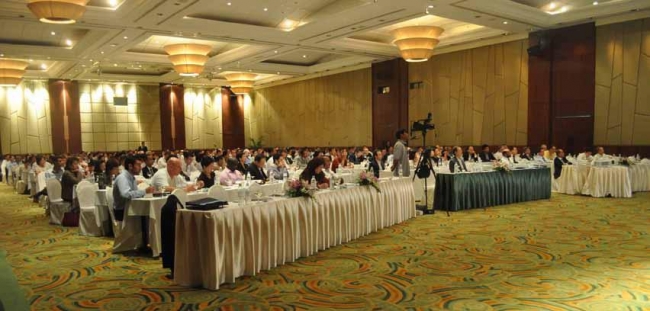
Attended by 423 delegates from 42 countries, the second World Rice Conference featured extensive analysis of demand and supply scenarios from leading analysts. (Photo: The Rice Trader)
New risk elements and climate change dominated the proceedings of The Rice Trader’s (TRT) second World Rice Conference in Phuket, Thailand, 12-14 October 2010. In 2009, the market was rocked by the surge of Philippine demand after Typhoon Ketsana (see Drowned harvest and other photos of typhoon damage) destroyed much of the country’s crops. The following year saw more nations struggle with the impacts of climate change.
China first battled against drought during the early part of the year, and then with floods. Inclement weather also spread across the Asian region, bringing the worst floods in years to Pakistan and even to Thailand.
Untimely rains also affected crop output in Cambodia and Indonesia. These tips in the balance of rice production pushed countries to seek measures that would ensure long-term food security both nationally and regionally. To make things more complicated, fluctuations of the U.S. dollar and euro affected currencies around the world. And, as if that was not enough, Russia and the Black Sea region banned wheat exports, further fracturing the global cereal supply.

- Bangladesh’s Additional Secretary for the Food Division (Ministry of Food and Disaster Management) Abdul Awal Howlader provides insights into Bangladesh’s active role in the market in 2010, and even in 2011.
Attended by 423 delegates from 42 countries, the conference once again featured extensive analysis of demand and supply scenarios from leading analysts. It also added critical views from major importing countries such as Indonesia, Iraq, the Philippines, and Bangladesh as well as the more Rice traders see a bumpy road in 2011 as financial risks and climate change rocked the markets of commercially oriented views from traders. These traders, who are involved in key African import markets, revealed the concerns of buyers that represent both the public and private sector within the global rice trade. Furthermore, the conference saw the “Big 5” exporters reveal expectations for 2011. Exporters (and millers) from Thailand, Vietnam, Pakistan, the U.S., and India were joined by representatives from the emerging export markets of Myanmar and Cambodia to paint a picture of supply, availability, and export potential, as the audience measured intelligence from both supply and demand to develop views on the possible shape of price, as well as the “critical control points” within the global rice supply chain that need to be watched as supply and availability unfold with each harvest.2010 in a nutshellTRT President/CEO and conference chairman Jeremy Zwinger revealed that 2010 was initially dominated by India’s no-show as an importer. He said that India’s strategy to risk relying on its own stocks after drought cut its overall rice production for 2009-10 down to 89 million tons from 99 million tons in 2008-09 and bank on recovery from the monsoon in 2010 to boost output back up to a more comfortable level was “one of the biggest bets taken in the history of the rice industry.” Consequently, India’s decision to stay out of the market sent prices significantly lower—compared to the price hikes induced by the series of Philippine tenders announced in the third quarter of 2009—during the early part of 2010.In India’s place, however, Bangladesh and Indonesia came in with a large demand in tow. This has created a bullish scenario for 2011, even though India’s output has recovered on the back of a better monsoon in 2010.Indonesia and Bangladesh are expected to continue to play an active role in 2011 that should heat up the global markets as they purchase strategic stocks and supplies needed to sustain food security requirements and cool local markets where prices have been rising (as was the case for Indonesia in 2010).________________________________________________________________________________







